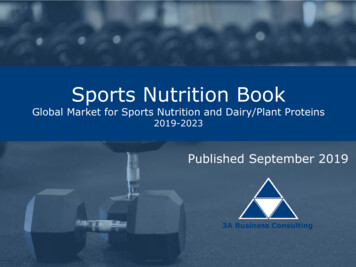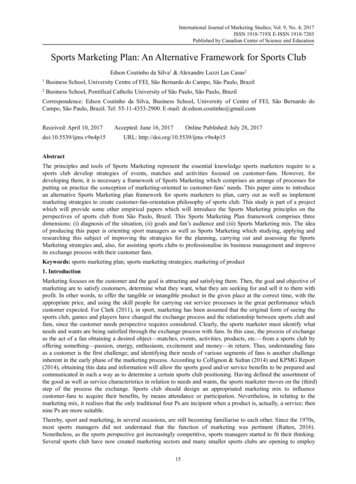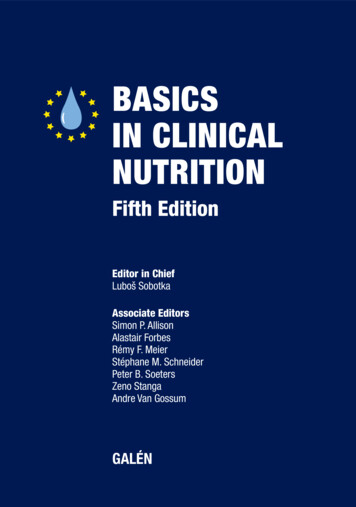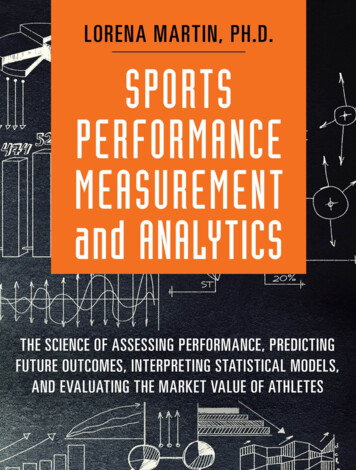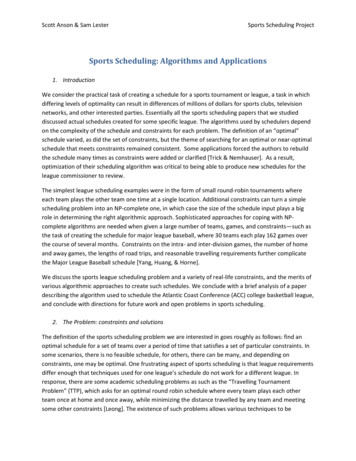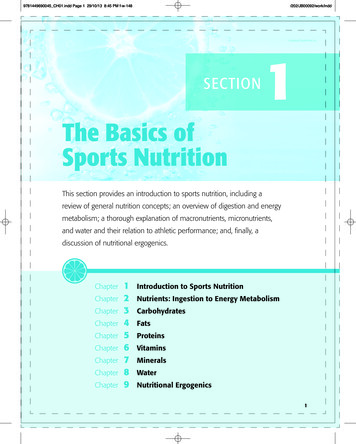
Transcription
9781449690045 CH01.indd Page 1 29/10/13 8:45 PM f-w-148/202/JB00092/work/indd pixelman/ShutterStock, Inc.SECTION1The Basics ofSports NutritionThis section provides an introduction to sports nutrition, including areview of general nutrition concepts; an overview of digestion and energymetabolism; a thorough explanation of macronutrients, micronutrients,and water and their relation to athletic performance; and, finally, adiscussion of nutritional terChapterChapterChapter123456789Introduction to Sports NutritionNutrients: Ingestion to Energy sWaterNutritional Ergogenics1
9781449690045 CH01.indd Page 2 29/10/13 8:45 PM f-w-148/202/JB00092/work/indd
9781449690045 CH01.indd Page 3 29/10/13 8:45 PM f-w-148/202/JB00092/work/indd pixelman/ShutterStock, Inc.CHAPTER1Introduction toSports NutritionKey Questions Addressed What is sports nutrition? Why study sports nutrition? What are the basic nutrients? How does the body produce energy? What are the Dietary Reference Intakes? What are enriched and fortified foods? What are the basic nutrition guidelines? How should athletes interpret the information on food labels? What are the factors to consider when developing an individualized sports nutrition plan for athletes? How can sports nutrition knowledge be converted into practical applications?You Are the Nutrition CoachJennifer is a 42-year-old tennis player. She states that recently her energy levels have dropped andthat she has had a hard time recovering from long tennis matches. She also complains of being“hungry all the time.” The constant hunger has been frustrating because she is trying to maintain hercurrent weight by attempting to control her total daily intake. She has been “eating well” sincefinding out 2 years ago that she has high cholesterol. She received counseling from a dietitian at thetime of her diagnosis and subsequently made major changes in her diet, such as switching to nonfatfoods and eliminating dairy. Her goals are to increase her energy levels, decrease recovery time, andcreate a meal plan that will also be healthy for her husband and three sons.Question What should Jennifer’s top priority be—her high cholesterol, struggle to maintain her weight,constant hunger, low energy levels, or long recovery time?3
9781449690045 CH01.indd Page 4 29/10/13 8:45 PM f-w-148 What is sports nutrition?Sports nutrition is a specialization within the field of nutrition that partners closelywith the study of the humanbody and exercise science. Sports nutrition can bedefined as the application of nutrition knowledge toa practical daily eating plan focused on providing thefuel for physical activity, facilitating the repair andrebuilding process following hard physical work,and optimizing athletic performance in competitiveevents, while also promoting overall health and wellness. The area of sports nutrition is often thoughtto be reserved only for “athletes,” which insinuatesthe inclusion of only those individuals who are performing at the elite level. In this text, the term athlete refers to any individual who is regularly active,ranging from the fitness enthusiast to the competitive amateur or professional. Differences may existin specific nutrient needs along this designated spectrum of athletes, creating the exciting challenge ofindividualizing sports nutrition plans.To fully understand andsubsequently apply sportsnutrition concepts, professionals instructing athletesThe field of sports nutrition requires a commandon proper eating strategiesof general nutrition andfirst need to have a comexercise science, anmand of general nutritionunderstanding of theiras well as exercise science.interrelationship, and theThe second step is to gainknowledge of how to practically apply sports nutritionthe knowledge of how nuconcepts.trition and exercise scienceare intertwined, understanding that physical training and dietary habits are reliant on each other toproduce optimal performance. The final step canbe considered one of the most critical—the practical application of sports nutrition knowledge toindividual athletes participating in a sport or physical activity.Sports nutrition professionals must be able toteach athletes by putting “book” knowledge intopractice with actual food selection and meal planning, while keeping in mind the challenges presentedby busy schedules of exercise, competitions, work,school, and other commitments. It is this third stepthat many professionals lack after graduating froman undergraduate or graduate program in sports nutrition, dietetics, exercise science, or athletic training.sports nutrition A specialty area ofstudy and practice within the fieldof nutrition.4CHAPTER 1 Introduction to Sports Nutrition/202/JB00092/work/inddOur focus is to review sports nutrition concepts whilealso translating the information into specific mealplans, recipes, and case study scenarios. Students areencouraged to seek additional opportunities outsidethe classroom to work with recreational and eliteathletes to gain more experience in applying sportsnutrition concepts before searching for a job in the“real world.” Why study sports nutrition?Sports nutrition has recently emerged as a recognizedspecialty area within the field of nutrition. Athleteschallenge their bodies on a regular basis throughphysical training and competitions. To keep up withthe physical demands ofThe field of sports nutritheir activity or sport, athtion is growing, increasingletes need to fuel their bodthe demand for qualifiedies adequately on a dailysports nutrition professionals. To be consideredbasis. This fueling processan “expert” in sports nutrirequires a specialized aption, a professional mustproach; therefore, athletesobtain the appropriatewho want to make dietaryeducation and certificachanges should seek out protion background as wellfessionals who are expertsas hands-on experienceworking with athletes.in sports nutrition and experienced in developing individualized plans.Because of its relative infancy, sports nutritionresearch is providing new and exciting informationon a regular basis. It is critical that sports nutritionprofessionals stay current so they can be evidencebased practitioners. Gone arethe days of suggesting dietary evidence-based practitioner Anpractices based on anecdotal individual whose professionalpractice is based upon information,observations or experiences. guidelines, or interventions thatBecoming an evidence-based have been shown throughpractitioner requires use of research to be safe and effective.nutrition guidelines and dietary practices that have been documented as beingeffective through peer-reviewed research. Professionals who have studied sports nutrition, have experience in the field, and continue to stay abreast of thelatest nutrition research can prescribe individualizeddietary plans that meet basic nutritional needs, enhance performance, and speed recovery in athletes ofall sports. Becoming an evidence-based sports nutrition practitioner can lead to an exciting and fulfilling career.
9781449690045 CH01.indd Page 5 29/10/13 8:45 PM f-w-148 What are the basic nutrients?Foods and beverages are composed of six nutrientsthat are vital to the human body for producing energy, contributing to the growth and developmentof tissues, regulating body processes, and preventingdeficiency and degenerativeessential A nutrition descriptordiseases. The six nutrientsreferring to nutrients that mustbe obtained from the diet.are carbohydrates, proteins,macronutrients These includefats, vitamins, minerals, andcarbohydrates, proteins, and fatswater and are classified asand are classified as suchessentialnutrients. The bodybecause they have caloric valueand the body has a large dailyrequires these nutrients toneed for them.function properly; however,micronutrients Vitamins andthe body is unable to endogminerals are classified asenously manufacture them inmicronutrients because thebody’s daily requirements forthe quantities needed daily,these nutrients are small.and therefore these nutrientsmust be obtained from thediet. Carbohydrates, proteins, and fats are classifiedas macronutrients because they have a caloric valueand the body needs a large quantity of them on adaily basis. The micronutrients include vitamins andminerals; the prefix micro is used because the body’sdaily requirements for these nutrients are small.Water fits into its own class, and requirements forit vary greatly among individuals. These nutrientswill be discussed briefly in this section.What are carbohydrates?Carbohydrates are compounds constructed of carbon, hydrogen, and oxygen molecules. Carbohydrates are converted into glucose in the body,providing the main source of fuel (4 calories pergram of carbohydrate) for all physical activity. Carbohydrates are found in a wide variety of foods, including grains, fruits, and vegetables, as well as inthe milk/alternative (soy, rice, nut, and other nondairy products) group.What are proteins?Amino acids are the building blocks of proteins,which are constructed of carbon, hydrogen, oxygen,and nitrogen molecules. Amino acids can be madewithin the body (nonessential) or obtained from dietary sources. Proteins are innonessential A nutrient descriptorvolved in the development,referring to nutrients that can begrowth, and repair of musmade within the body.cle and other bodily tissuesand are therefore critical for recovery from intensephysical training. Proteins ensure that the body stays/202/JB00092/work/inddhealthy and continues working efficiently by aidingin many bodily processes. Protein can also be usedfor energy, providing 4 calories per gram; however,it is not used efficiently and therefore is not a sourceof energy preferred by the body. Proteins are foundin a variety of foods, including grains and vegetables,but are mainly concentrated in the milk/alternative aswell as meat and beans/alternative (soy products, nuts,seeds, beans, and other nonanimal products) groups.What are fats?Fats, like the other macronutrients, are compoundsmade up of carbon, hydrogen, and oxygen molecules.Fats are also known as lipids, and they come fromboth plant and animal sources in our diet. Triglycerides are the most common type of fat. Other fats include cholesterol and phospholipids. With 9 caloriesper gram, fats are a concentrated source of energy.Fat is primarily used as a fuel at rest and during lowto moderate-intensity exercise. Fats are also involvedin providing structure to cell membranes, aiding inthe production of hormones, forming the insulationthat wraps nerve cells, and facilitating the absorption of fat-soluble vitamins. Fats are concentrated inbutter, margarines, salad dressings, and oils, but theyare also found in meats, dairy products, nuts, seeds,olives, avocados, and some grain products.What are vitamins?Vitamins are a large class of nutrients that containcarbon and hydrogen, as well as possibly oxygen,nitrogen, and other elements. There are two mainrequirements for a substance to be classified as avitamin. First, the substance must be consumed exogenously because the body cannot produce it orcannot produce it in sufficient quantities to meetits needs. Second, the substance must be essentialto at least one vital chemical reaction or processin the human body. Vitamins do not directly provide energy to the body; however, some vitaminsaid in the extraction of energy from macronutrients. Vitamins are involved in a wide variety ofbodily functions and processes that help to keepthe body healthy and disease free. Vitamins areclassified as either water soluble (B vitamins andvitamin C) or fat soluble (vitamins A, D, E, and K),depending on their method of absorption, transport, and storage in the body. Vitamins are foundin nearly all foods, including fruits, vegetables,grains, meat and beans/alternative, milk/alternative, and some fats.What are the basic nutrients?5
9781449690045 CH01.indd Page 6 29/10/13 8:45 PM f-w-148What are minerals?Minerals are also a large group of nutrients. They arecomposed of a variety of elements; however, they lackcarbon. Minerals have a role in the structural development of tissues as well as the regulation of bodily processes. Physical activity placesdemands on muscles andbones, increases the need forEach of the six nutrientshas a role in the healthoxygen-carrying compoundsand proper functioning ofin the blood, and increasesthe human body. Physicalthe loss of sweat and elecactivity places extratrolytes from the body, all ofdemands on the body,which hinge on the adequateincreasing the importanceintake and replacement of diof the nutrients’ presencein the diet. Many of theetary minerals. Minerals arenutrients are so criticalcategorized into major minerto optimal athletic perals (calcium, sodium, potasformance that the totalsium, chloride, phosphorus,daily requirements aremagnesium, and sulfur) andincreased to meet thedemands placed on thetrace minerals (iron, zinc, copbody. The six basic nutriper, selenium, iodine, fluoride,ents each have distinct,molybdenum, and mangabut also intertwining,nese) based on the total quanroles, making it criticaltity required by the body onto consume adequatea daily basis. Similar to vitaamounts of each nutrienton a daily basis.mins, minerals are found ina wide variety of foods, butmainly are concentrated in themeat and beans/alternative and milk/alternative groups.What is water?Forming a category of its own, water deserves to behighlighted because of its vital roles within the body.The human body can survive for a much greaterlength of time without any of the macro- or micronutrients than without water. The body is 55–60%water, representing a nearly ubiquitous presence inbodily tissues and fluids. In athletics, water is important for temperature regulation, lubrication of joints,and the transport of nutrients to active tissues. Inaddition to plain water, water can be obtained fromjuices, milk, coffee, tea, and other beverages, as wellas watery foods such as fruits, vegetables, and soups. How does the body produce energy?The body derives its energy from foods ingesteddaily. Carbohydrates, fats, and proteins are knownas the energy nutrients because they serve as thebody’s source for energy. These energy nutrients arequite literally chemicals that have energy trapped6CHAPTER 1 Introduction to Sports Nutrition/202/JB00092/work/inddwithin the bonds between the atoms of which theyare made. The energy trapped within these nutrientsis released when metabolicpathways within the cells energy nutrients Carbohydrates,and fats serve as thebreak down the foods into proteins,body’s source of energy and aretheir constituent parts, car- considered the energy nutrients.bon dioxide and water. Some adenosine triphosphate (ATP) Theof the energy released is con- molecule that serves as the body’sserved or captured and used direct source of energy for cellularwork.to make another high-energychemical called adenosinetriphosphate (ATP). The rest of the energy is lost asheat. ATP is the body’s direct source of energy forcellular work. Without a constant source of ATP,muscles would not be able to generate force, andthus athletes would not be able to move or performany physical activity. What are the DietaryReference Intakes?Several different terms areused to describe the recommendations for macronutrients and micronutrients.The Recommended DietaryAllowances (RDAs) weredeveloped in 1941 by theU.S. National Academy ofSciences. The RDAs werethe primary values healthprofessionals used to assessand plan diets for individuals and groups and to makejudgments about excessiveintakes. The RDAs still exist for many nutrients; however, a newer way to quantifynutrient needs and excessesfor healthy individuals hasbeen developed and termedthe Dietary Reference Intakes (DRIs). The DRIs expand on the RDAs and takeinto consideration other dietary quantities such as Estimated Average Requirement(EAR), Adequate Intake (AI),and Tolerable Upper IntakeLevel (UL). DRIs are continually being reviewed, andreports on various groupsRecommended Dietary Allowance(RDA) The average daily dietaryintake level that is sufficient tomeet the nutrient requirements ofthe overwhelming majority (i.e.,98%) of a healthy population.Dietary Reference Intakes (DRIs) Anewer way to quantify nutrientneeds and excesses for healthyindividuals. The DRI expands onthe older Recommended DietaryAllowance (RDA) and takes intoconsideration other dietaryquantities such as EstimatedAverage Requirement (EAR),Adequate Intake (AI), and TolerableUpper Intake Level (UL).Estimated Average Requirement(EAR) The estimated daily intakelevel of a vitamin or mineralneeded to meet the requirements,as defined by a specified indicatorof adequacy, of half of the healthyindividuals within a given life stageor gender group.Adequate Intake (AI) A referenceintake for nutrients that is usedinstead of the RecommendedDietary Allowance. Wheninsufficient scientific evidence isavailable to calculate an EstimatedAverage Requirement (EAR), thenan AI is used. Similar to the EARand the Recommended DietaryAllowance (RDA), the AI values arebased on intake data of healthyindividuals.Tolerable Upper Intake Level(UL) The highest level of dailynutrient intake that poses noadverse health effects for almostall individuals in the generalpopulation.
9781449690045 CH01.indd Page 7 29/10/13 8:45 PM f-w-148of nutrients are publishedas scientific data are gathThe DRIs encompassered. This comprehensivethe EAR, RDA, AI, andeffort to develop all compoUL for each macronutrinents of the DRIs is underent, vitamin, and mineralbased on recent researchthe auspices of the Standingand epidemiological dataCommittee on the Scientificof healthy populations.Evaluation of Dietary RefAs more information anderence Intakes of the Fooddata are discovered, theseand Nutrition Board, the Inrecommendations will beupdated and revised.stitute of Medicine, and theNational Academy of Sciences of the United States,along with Health Canada.1 The definitions of thevarious DRIs are reviewed in Table 1.1. What are enriched and fortified foods?When grains are milled, the germ and bran are removed. Because the germ and bran contain a majority of the vitamins and minerals in whole grains, theresulting refined product is less nutritious. Refinedgrain products include white flours, bread, pasta, rice,crackers, and cereals. To prevent deficiency diseases,the Food and Drug Administration (FDA) mandated in1943 that the nutrients lostEnrichment and fortificaduring the milling process oftion of foods and beverwheat, rice, and corn be reages are intended to helpplaced. The nutrients identiindividuals meet their dailyfied and thus added to refinednutrient needs.grain products include thia-/202/JB00092/work/inddmin, riboflavin, niacin, and enrichment The addition ofiron. The addition of vitamins vitamins and minerals to refined/processed products to increaseand minerals to refined prod- their nutritional value.ucts is termed enrichment.fortification The process of addingFortification is the ad- vitamins or minerals to foods ordition of a vitamin or min- beverages that did not originallyeral to a food or beverage in contain them.which it was not originallypresent. The first successful fortification programwas the addition of iodine to salt in the 1920s toprevent goiter and other iodine deficiency conditions. In general, fortification is not required by theFDA, with the exception of folic acid in grains andvitamin D in milk. Other fortification programsare designed to enhance the quality of a product,such as the addition of vitamin A to milk and otherdairy foods, as well as lysine to specific corn products to enhance protein quality. The food industryhas the freedom to add any vitamin or mineral toa product. However, the FDA does require companies to show that a dietary insufficiency existsand therefore requires fortification in otherwisestandardized products. Some products contain vitamins or minerals not naturally found in the foodor beverage, such as added vitamin D and vitaminB12 in soy milk. Other products boost existing vitamin or mineral content, such as extra vitamin Cadded to orange juice. Sport supplements, such asbars and shakes, are highly fortified with a varietyof vitamins and minerals. Athletes should checklabels to ensure that their total daily consumptionof any vitamin or mineral is not in excess of upperTABLE1.1Review of the Nutrient Intake DescriptorsDescriptorDefinitionDietary Reference Intake (DRI)Recommended DietaryAllowance (RDA)Umbrella term for all nutrient classifications, including RDA, EAR, AI, and UL.Average daily dietary intake level that is sufficient to meet the nutrient requirements of nearlyan entire (i.e., 98%) healthy population. The established RDAs can vary based on life stage,including age; gender; and, if appropriate, pregnancy and lactation.Daily intake level of a vitamin or mineral estimated to meet the requirements, as defined by aspecified indicator of adequacy in half of the healthy individuals within a life stage or gendergroup.Intake recommendation when insufficient scientific evidence is available to calculate an EAR/RDA. AI values are based on intake data of healthy individuals. However, the results ofstudies regarding the nutrient in question are not conclusive enough or more study isrequired before an EAR/RDA can be established.The highest level of daily nutrient intake that poses no adverse health effects for almost allindividuals in the general population. At intakes above the UL, the risk of adverse effectsincreases.Estimated AverageRequirement (EAR)Adequate Intake (AI)Tolerable Upper Intake Level(UL)What are enriched and fortified foods?7
9781449690045 CH01.indd Page 8 29/10/13 8:45 PM f-w-148dietary limits. For more information about enrichment and fortification, visit the FDA’s website atwww.fda.gov. What are the basic nutrition guidelines?The keys to healthful eating are to consume a dietthat provides adequate nutrients to maintain health,includes a variety of foods, is balanced, and is consumed in moderation. Government agencies havedeveloped several tools that provide general healthful eating guidelines that include balance, variety,and moderation to help the American populationmaintain or improve health. The Dietary Guidelinesfor Americans and the MyPlate2 food guidance system are two such tools that convert scientific evidence into practical applications that Americans canuse to eat more healthfully. These general guidelinesare applicable to sedentary and athletic individuals alike.8CHAPTER 1 Introduction to Sports NutritionThe four interrelated themes and the key recommendations from the 2010 Dietary Guidelinesreport are as follows (www.dietaryguidelines.gov):31. Balance Calories to Manage Weight Prevent and/or reduce overweight and obesitythrough improved eating and physical activitybehaviors. Control total calorie intake to manage bodyweight. For people who are overweight orobese, this means consuming fewer caloriesfrom foods and beverages. Increase physical activity (seeFigure 1.1 ) andreduce time spent in sedentary behaviors. Maintain appropriate calorie balance duringeach stage of life—childhood, adolescence,adulthood, pregnancy and breastfeeding, andolder age.2. Reduce the Following Foods and FoodComponents Reduce daily sodium intake to less than 2300milligrams (mg) and further reduce intake to1500 mg among persons who are 51 andolder and those of any age who are African Galina Barskaya/Shutterstock, Inc.What are the Dietary Guidelines for Americans?The Dietary Guidelines for Americans, developedjointly by the U.S. Department of Health and Human Services (HHS) and the U.S. Department ofAgriculture (USDA), are revised and publishedevery 5 years. The first Dietary Guidelines werepublished in 1980. The most recent version of theDietary Guidelines for Americans was publishedin 2010.3 The guidelines provide science-basedadvice for people 2 years and older on dietary andphysical activity habits that can promote healthand reduce the risk for chronic illnesses and conditions such as cardiovascular disease, diabetes,and hypertension. A healthful diet that is not excessive in calories, follows the nutrition recommendations contained in the guidelines, and iscombined with physical activity should enhancethe health of most individuals.The primary purpose of the Dietary Guidelines is to provide the public with informationabout nutrients and food components that areknown to be beneficial for health and to providerecommendations that can be implemented intoan eating and exercise plan. The 2010 DietaryGuidelines cover four interrelated focus areas.When the guidelines are implemented as a whole,they encourage Americans to: (1) maintain caloriebalance over time to achieve and sustain a healthyweight and (2) focus on consuming nutrient-densefoods and beverages./202/JB00092/work/inddFigure 1.1Exercising regularly, combined with a diet thatdoes not exceed calorie needs, helps manage weight.
9781449690045 CH01.indd Page 9 29/10/13 8:45 PM f-w-148American or have hypertension, diabetes, orchronic kidney disease. The 1500 mg recommendation applies to about half of the U.S.population, including children, and the majority of adults. Consume less than 10% of calories fromsaturated fatty acids by replacing them withmonounsaturated and polyunsaturated fattyacids. Consume less than 300 mg per day of dietarycholesterol. Keep trans fatty acid consumption as low aspossible by limiting foods that contain synthetic sources of trans fats, such as partiallyhydrogenated oils, and by limiting other solidfats. Reduce the intake of calories from solid fatsand added sugars. Limit the consumption of foods that containrefined grains, especially refined grain foodsthat contain solid fats, added sugars, and sodium. If alcohol is consumed, it should be consumedin moderation—up to one drink per day forwomen and two drinks per day for men—andonly by adults of legal drinking age.3. Increase Intake of the Following Foods andNutrientsIndividuals should meet the following recommendations as part of a healthy eating patternwhile staying within their calorie needs. Increase vegetable and fruit intake. Eat a variety of vegetables, especially darkgreen, red, and orange vegetables and beansand peas. Consume at least half of all grains as wholegrains. Increase whole grain intake by replacing refined grains with whole grains. Increase intake of fat-free or low-fat milk andmilk products, such as milk, yogurt, cheese,or fortified soy beverages. Choose a variety of protein foods, which include seafood, lean meat and poultry, eggs,beans and peas, soy products, and unsaltednuts and seeds. Increase the amount and variety of seafoodconsumed by choosing seafood in place ofsome meat and poultry. Replace protein foods that are higher in solidfats with choices that are lower in solid fatsand calories and/or are sources of oils. Use oils to replace solid fats where possible./202/JB00092/work/inddChoose foods that provide more potassium,dietary fiber, calcium, and vitamin D, whichare nutrients of concern in American diets.These foods include vegetables, fruits, wholegrains, and milk and milk products.Recommendations for specific populationgroups: Women capable of becoming pregnanta. Choose foods that supply heme iron(which is more readily absorbed by thebody), additional iron sources, and enhancers of iron absorption such as vitamin C–rich foods.b. Consume 400 micrograms (mcg) per dayof synthetic folic acid (from fortified foodsand/or supplements) in addition to foodforms of folate from a varied diet. Women who are pregnant or breastfeedinga. Consume 8 to 12 ounces of seafood perweek from a variety of seafood types.b. Due to its high methyl mercury content,limit white (albacore) tuna to 6 ounces perweek and do not eat the following fourtypes of fish: tilefish, shark, swordfish, andking mackerel.c. If pregnant, take an iron supplement, asrecommended by an obstetrician or otherhealthcare provider. Individuals aged 50 years and oldera. Consume foods fortified with vitamin B12,such as fortified cereals, or dietary supplements.4. Build Healthy Eating Patterns Select an eating pattern that meets nutrientneeds over time at an appropriate calorielevel. Account for all foods and beverages consumedand assess how they fit within a total healthyeating pattern. Follow food safety recommendations whenpreparing and eating foods to reduce the riskof foodborne illnesses.Although the Dietary Guidelines listed herewere developed with the American population’shealth in mind, athletes can benefit from implementing the guidelines in their daily nutritionplanning. By selecting a variety of nutrient-densefoods, as dictated in the guidelines, athletes canmeet their energy, macronutrient, and micronutrient needs for a high level of sport performance.The MyPlate food guidance system can be usedto further plan an athlete’s daily food intake by What are the basic nutrition guidelines?9
9781449690045 CH01.indd Page 10 29/10/13 8:45 PM f-w-148practically applying the information in the Dietary Guidelines.What is the MyPlate food guidance system?The USDA released the MyPlate food guidancesystem in 2011 (www.ChooseMyPlate.gov). TheUSDA’s Center for Nutrition Policy and Promotion, established in 1994, developed the MyPlatesystem to improve the nutrition and well-being ofAmericans. The MyPlate system (see Figure 1.2 ) isa revision of the MyPyramid that was released in2005. The new icon was developed for two mainpurposes: (1) to improve the effectiveness in motivating consumers to make healthier food choicesand (2) to incorporate the latest nutrition scienceinformation into the new system. MyPlate and theDietary Guidelines for Americans complement eachother and can provide basic guidelines and practicalapplications fo
an undergraduate or graduate program in sports nu-trition, dietetics, exercise science, or athletic training. sports nutrition A specialty area of study and practice within the field of nutrition. The field of sports nutri-tion is growing, increasing the demand for qu
